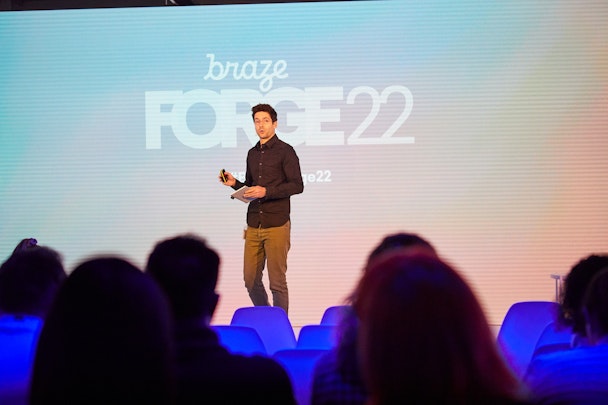The customer journey roadmap: ‘Each customer is unique, treat them that way’
Warner Bros Discovery’s Yoav Banai shares a set of guiding principles to create customer engagement and retention journeys that drive real business impact.

Yoav Banai sets the scene at Braze's Forge event
The ideal scenario for anyone who really wants to know their customers is to be in the same room with them. Think back to the original media subscription business: the local library. Customers could browse on their own through clearly organized bookshelves with “staff pick” on post-it notes to draw attention to both fresh and classic material. Meanwhile, staff were on hand to help find a specific title or share personalized recommendations for the specific client.
Now, compare these tactics to what marketers use in the digital world today – how would those look if applied directly to that in-person library setting? In-app messaging as post-it notes handed to each person walking through the door, newsletter emails as generic recommendations broadcasted on the loudspeaker, and forcing people to meander through a pre-specified path through irrelevant aisles even when they know exactly which title they want and where that title is located. This could turn customers off from ever wanting to come back.
This is the scenario Yoav Banai, group vice-president, retention and engagement, Warner Bros Discovery, used to set the scene for his masterclass on mapping out customer journeys at Braze’s Forge 2022 event. “Everything we’re doing is relevant at [a particular] moment because we’re doing it by lifecycle junctions,” he explained.
For marketers to get into this mindset, they must start by building the right foundations – and this approach is relevant no matter your business model or industry. “After we’ve gotten to the right foundational infrastructure and into the right mindset, only then [can we get] to mapping the customer journey.”
Advertisement
Measure what matters
Core to this is measuring what matters. Marketers don’t need to know if Leonard opened an email, they need to know if they won him back as a customer or if he streamed more.
It starts with understanding the actual goal of the business, said Banai: “Stop measuring proxy KPIs that really don’t tell us anything, like open rates or click-through rates. Those are just distractions. Forget about [them], they will take you down the wrong paths. Focus on downstream KPIs and measure what matters, like sales, streams, or session starts.”
Marketers should optimize on a cohort level, not on a campaign level, he said: “All campaigns play a part and work together, and what we really want to know is how your entire strategy is impacting your cohort to generate more sales or streams.”
Advertisement
Not your average customer
Remember that each customer is unique and should be treated that way, said Banai. “There’s no such thing as an average customer,” he said. “If you’re planning for the average customer, your campaigns are not going to resonate with anyone.
“Forget about personas or segments – those are just averages of a subset of your customer base – they’re not relevant, they don’t exist. If you’re sending a campaign on a one-to-cohort, or one-to-segment, the chances are most of your users are either not reading it or it doesn’t help them.” Explore tools to be able to tailor campaigns on a one-to-one level, he advised.
Suggested newsletters for you
Clean up your act
With the industry, customer, and technology changing, marketeers “can’t run the same show forever” and every so often should “take a sprint to audit everything,” said Banai. “Sit down and audit every single ongoing campaign to see what makes an impact and what doesn’t. If [a campaign] doesn’t make an impact or you’re in doubt, just kill it.”
Focus on the campaigns that matter. “If you need to run a breadcrumb analysis before you do this exercise to remind yourself or re-understand what a healthy customer journey is, do it,” said Banai. “Look at all your campaigns. Kill everything that doesn’t help you. Leave the few that make an impact. Bring a fresh pair of eyes. Refresh your act.”
Do less, but do it better
Only a handful of campaigns will make the majority impact for your customers – so focus time and energy on improving and iterating those that do matter.
“Run different variants to see which types work better over and over again,” he said. “Stop adding more and more campaigns that have a small impact on a small sub-niche of your customer base. Focus on the ones that touch all your customers, that have the big impact – whether these are onboarding journeys, rescue journeys or whatever it is for your business.”
Focus on the “superhero” campaigns and make sure that all campaigns – regardless of channel or device – go through one pipeline and are built in a way that is scalable. Build everything in a personalized and conversational way, so that campaigns are relevant to every user that needs them. “That would have a much bigger impact on your business,” said Banai.
Mapping the customer journey
With the foundations in place, marketeers can get on with mapping the customer journey. Banai offers a set of guiding principles around the why, who, when, what and where behind campaigns:
-
Start with “Why”: Before anything else, look at why you are sending this campaign and the impact you’re trying to achieve. Content might be the ammunition, but it’s not the goal.
-
Action-based “Who”: The answer to who you should send to is action-based and determined by junctions in the lifecycle of a customer where they might need a nudge or help to get on the right track.
-
Triggers determine “When”: Once you find those junctions and understand who is entering those intersections, the trigger should be determined by that moment, not by time.
-
Follow cues on “What”: Make the message one-to-one, personalized, and dynamic so that it renders to the user and the action, harnessing cues and hints from the customer.
-
No right or wrong to “Where”: The message needs to reach the customer at that junction and at that time. Build it in a way that is channel flexible and dynamic, or that has backup channels so it always reaches the destination timely.
To watch Banai’s full presentation and catch other highlights from Braze Forge 2022, click here.
Content created with:

Braze
Braze is the customer engagement platform for leading brands. We unite data, technology, and teams to create brilliant messaging experiences.
Find out more
